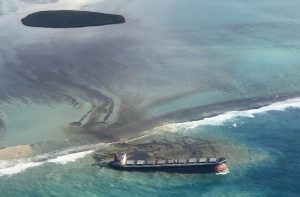Last week the Japanese cargo carrier MV Wakashio, which ran aground off the southeast coast of Mauritius in July, began leaking fuel through cracks in the hull, sparking an environmental disaster. The large-scale bulk carrier is in the process of breaking up into two pieces after crashing into a coral reef. Mauritius, which is a rich hotspot for biodiversity, is bracing for a worst-case scenario as an estimated 1,000 metric tons of leaked heavy oil risks bleaching coral reefs and destroying nearby protected marine ecosystems. Dead fish, eels, and starfish are already washing ashore.
The Mauritian government declared a national emergency and appealed for international help to contain the spill around the protected Blue Bay Marine Park wetlands and Ile aux Aigrettes, an island that is home to rare and endangered species internationally recognized under the Ramsar Convention.
French and Japanese oil spill experts arrived with technical assistance to stop the spread of oil as well new oil leakage into surrounding lagoons. Starting last Friday local volunteers began improvising homemade floating oil booms by weaving together human hair, sugar cane grass, clothing, and nylon. But satellite images reveal a worsening spread of oil as the cargo carrier continues to drift north and oil seeps through the makeshift boom barriers.
Local authorities spent two days racing to remove 1,800 metric tons of oil on board before the vessel broke apart. Two ships and a helicopter arrived on Monday to help transport fuel being pumped out of an undamaged fuel tank through a hose connection. A small amount of oil remains in one part of the damaged tank, having mixed with seawater, but a large amount of oil in another part of the damaged tank is expected to flow out.
The ship is operated by the Tokyo headquartered Mitsui O.S.K. Lines — one of the largest freight shipping companies in the world — but the cargo vessel itself is owned by the Okayama-based Nagashiki Shipping under a Panama flag. At a press conference on Tuesday Vice President of Mitsui O.S.K. Lines Akihiko Ono apologized profusely for ”causing problems” and pledged to make every effort to find a solution.
Compensation for the environmental damage and loss of livelihoods is expected to be covered by liability insurance, but the full extent of the damage has yet to be determined in the absence of an official environmental impact assessment. Mitsui O.S.K Lines is not expected to face direct liability, with responsibility lying on the ship owner. Ono said at this stage they were unable to give a ballpark figure for the damages, but “the company would respond sincerely in line with considering the enormous impact.” The ship owner liability limitation treaty and Bunker Treaty on oil pollution damage outlines an upper limit on the amount of compensation — in the case of marine accidents due to an oil spill, compensation is capped at $1 billion, with no limit set on ship removal costs. But if gross negligence is found, compensation claims on the ship owner may exceed the upper limit.
Prior to the global coronavirus pandemic, Mauritius attracted some 1.5 million tourists annually who flocked to enjoy its turquoise waters, marine life, lagoons, and coral reefs. Putting a dollar value on the amount of damage to fisheries, tourism-related businesses, and marine life will be an ongoing debate as environmental damage is expected to linger for years to come.
It’s not clear how the Japanese-owned cargo vessel ended up so close to shore in the first place. Mauritian authorities have launched an onsite investigation with the cooperation of the captain, in which logbooks are expected to be seized. According to Japan’s ClassNK inspection body, the vessel, which was built in 2007, passed an inspection test in March. After running aground, the ship was in a stable condition but rapidly deteriorated after being battered by 4 meter high waves and rough winds, which led to cracks and eventually fuel spilling on August 6.






























